
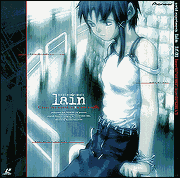
Produced by: Pioneer LDC
Character design: Yoshitoshi Abe
Written by: Konaka Chiaki
Directed by: Nakamura Ryutaro
© 1998 Triangle Staff/Pioneer LDC
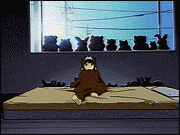
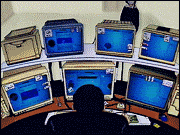
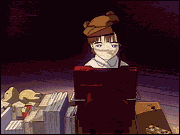
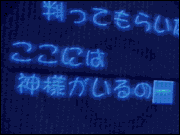

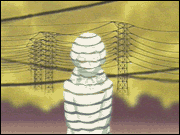
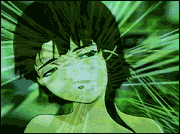
|
 |


—by Eric "Scanner" Luce
"Make me sad, make me mad, make me feel alright?"
This TV series aired on in Tokyo around the
beginning of July. With all the marketing effort put behind this series we
had a lot of expectation piled up on LAIN. There
is not only the series but the usual set of CDs, the
PlayStation game, and the books. We have not seen any UFO
catcher dolls yet or other such gimmicks but would not be surprised at their
existence.
 So, how is it? So, how is it?
 This show is going to take most viewers some time to get in to. The
first couple of episodes are story building. Not only are they trying
to build the setting but they can be extremely confusing. The opening
credits give a sense of this—mysterious juxtapositions of Lain and
moving backgrounds—people watching her on TV, a kid playing a video
game with her on the screen, a couple. Finally Lain walking off as
time remains suspended around her. The episodes begin with the caption
reading "Present day, Present time." They end with a disturbing laugh. This show is going to take most viewers some time to get in to. The
first couple of episodes are story building. Not only are they trying
to build the setting but they can be extremely confusing. The opening
credits give a sense of this—mysterious juxtapositions of Lain and
moving backgrounds—people watching her on TV, a kid playing a video
game with her on the screen, a couple. Finally Lain walking off as
time remains suspended around her. The episodes begin with the caption
reading "Present day, Present time." They end with a disturbing laugh.
 The first episode begins with a young girl committing suicide by
falling off of a tall building. We immediately notice how before she
does this the shadows in her world are filled with blood red
spots. After she lets go of the railing and falls to the ground her
handbag, abandoned, casts a shadow with red spots. The first episode begins with a young girl committing suicide by
falling off of a tall building. We immediately notice how before she
does this the shadows in her world are filled with blood red
spots. After she lets go of the railing and falls to the ground her
handbag, abandoned, casts a shadow with red spots.
 The next morning Lain is off to school. Her world is filled with the
loud hum of power lines that others do not seem to hear. The world is
over-bright and the shadows are filled with these blood red spots. The next morning Lain is off to school. Her world is filled with the
loud hum of power lines that others do not seem to hear. The world is
over-bright and the shadows are filled with these blood red spots.
 As Lain enters the school yard she looks down at her shadow and it is
filled with swirling gray patterns. As she looks up her school mates
fade out in a sea of white that Lain squints to see through. A
caption frame appears saying "Everyone, hurry..." When she gets to
her classroom, one of her classmates is crying and being comforted by two
others. She had received email from the girl who
killed herself. Lain is asked if she got mail also. Lain
says that she does not read her email. Her classmate, Alice, chides
her and tells her to check her mail every day. Alice goes on to say that
many people have gotten mail from the dead classmate. As Lain enters the school yard she looks down at her shadow and it is
filled with swirling gray patterns. As she looks up her school mates
fade out in a sea of white that Lain squints to see through. A
caption frame appears saying "Everyone, hurry..." When she gets to
her classroom, one of her classmates is crying and being comforted by two
others. She had received email from the girl who
killed herself. Lain is asked if she got mail also. Lain
says that she does not read her email. Her classmate, Alice, chides
her and tells her to check her mail every day. Alice goes on to say that
many people have gotten mail from the dead classmate.
 Later in the middle of class Lain has trouble seeing the chalk board
as the teacher writes on it. It all goes fuzzy and scattered. Lain
puts down her pencil and looks at her hand as it begins to spew
streams of fog from each finger. At home she turns on her neglected
Navi (computer) and interacts with the email that she has received
from her dead classmate. "Why did you kill yourself?" Lain asks. "God
is here (where I am.)" Later in the middle of class Lain has trouble seeing the chalk board
as the teacher writes on it. It all goes fuzzy and scattered. Lain
puts down her pencil and looks at her hand as it begins to spew
streams of fog from each finger. At home she turns on her neglected
Navi (computer) and interacts with the email that she has received
from her dead classmate. "Why did you kill yourself?" Lain asks. "God
is here (where I am.)"
 That night when Lain's father finally comes home with a new board for
his large computer array Lain goes to talk to him. Engrossed in his actions,
he barely notices her. He asks her what is wrong. It is unlike Lain to come
into his computer room. Her father seems engrossed in a sort of computer
mania and spends almost all of his spare time wired, online. That night when Lain's father finally comes home with a new board for
his large computer array Lain goes to talk to him. Engrossed in his actions,
he barely notices her. He asks her what is wrong. It is unlike Lain to come
into his computer room. Her father seems engrossed in a sort of computer
mania and spends almost all of his spare time wired, online.
 What is the story about? The brief description above gives you no real
clue. It is the conversation that starts to make you wonder. At the
end of the 2nd episode Lain says to a psychotic "No matter where,
people are connected." It is about being connected, being online,
being wired. Perhaps anyone who comes in contact with Lain is
connected? Other hints suggest that Lain has no physical place and
exists online. What is the story about? The brief description above gives you no real
clue. It is the conversation that starts to make you wonder. At the
end of the 2nd episode Lain says to a psychotic "No matter where,
people are connected." It is about being connected, being online,
being wired. Perhaps anyone who comes in contact with Lain is
connected? Other hints suggest that Lain has no physical place and
exists online.
 The story has the tension of a suspense series or a thriller. We are held
captive with clues and hints of a world that is opening around the people who
are increasingly online. It is not always a good world either. Where
it will lead us perhaps only Lain may know. The story has the tension of a suspense series or a thriller. We are held
captive with clues and hints of a world that is opening around the people who
are increasingly online. It is not always a good world either. Where
it will lead us perhaps only Lain may know.
 The art is rather simple. You get the feel of how the budget was
pushed towards the TV series. It also feels strongly reminiscent in
character designs of early TENCHI, GREEN LEGEND RAN,
and EL HAZARD. More
effort is spent on direction and scene changes than detail and frame count. The art is rather simple. You get the feel of how the budget was
pushed towards the TV series. It also feels strongly reminiscent in
character designs of early TENCHI, GREEN LEGEND RAN,
and EL HAZARD. More
effort is spent on direction and scene changes than detail and frame count.
 For the beginner in Japanese, the heavy use of dialog and written captions
will make the nuances and direction very hard to follow. However, this
title may be released domestically in the near future.
This is one of the more engaging series out this year that does not rely
upon the cowboy/bounty hunter/fight story and as such is a refreshing and
enjoyable change. For the beginner in Japanese, the heavy use of dialog and written captions
will make the nuances and direction very hard to follow. However, this
title may be released domestically in the near future.
This is one of the more engaging series out this year that does not rely
upon the cowboy/bounty hunter/fight story and as such is a refreshing and
enjoyable change.  |



